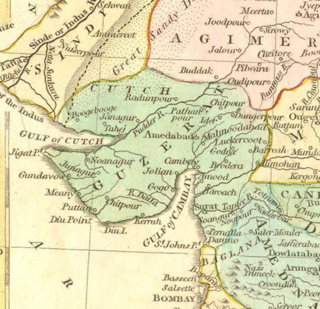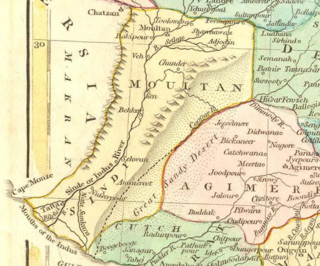
Mirza Shahab-ud-Din Muhammad Khurram, also known as Shah Jahan I, was the fifth Mughal emperor, reigning from 1628 until 1658. During his reign, the Mughals reached the peak of their architectural and cultural achievements.

Awadh, known in British historical texts as Avadh or Oudh, is a historical region in northern India, now constituting the northeastern portion of Uttar Pradesh. It is roughly synonymous with the ancient Kosala region of Hindu, Buddhist, and Jain scriptures.

Burhanpur is a historical city in the Indian state of Madhya Pradesh. It is the administrative seat of Burhanpur District. It is situated on the north bank of the Tapti River and 512 kilometres (318 mi) northeast of city of Mumbai, 340 kilometres (211 mi) southwest of the state's capital city of Bhopal. The city is a Municipal Corporation.

Mughal architecture is the type of Indo-Islamic architecture developed by the Mughals in the 16th, 17th and 18th centuries throughout the ever-changing extent of their empire in the Indian subcontinent. It developed from the architectural styles of earlier Muslim dynasties in India and from Iranian and Central Asian architectural traditions, particularly Timurid architecture. It also further incorporated and syncretized influences from wider Indian architecture, especially during the reign of Akbar. Mughal buildings have a uniform pattern of structure and character, including large bulbous domes, slender minarets at the corners, massive halls, large vaulted gateways, and delicate ornamentation; examples of the style can be found in modern-day Afghanistan, Bangladesh, India and Pakistan.

RajaTodar Mal was an Indian minister, economist, and military commander who served as the Finance Minister (Diwan-i-Ashraff) of the Mughal empire during the reign of Akbar I. He was also the Vakil-us-Sultanat and Joint Wazir. He was one of the premier nobles in the Mughal Empire and was a Mansabdar of 4000. He was one of the Navaratnas in Akbar's court. Under Todar Mal, there were 15 other Dewans nominated for 15 Subahs of Akbar.

Shah Alam II, also known by his birth name Ali Gohar, or Ali Gauhar, was the seventeenth Mughal emperor and the son of Alamgir II. Shah Alam II became the emperor of a crumbling Mughal Empire. His power was so depleted during his reign that it led to a saying in the Persian language, Sultanat-e-Shah Alam, Az Dilli ta Palam, meaning, 'The empire of Shah Alam is from Delhi to Palam', Palam being a suburb of Delhi.

Shahryar Mirza was the fifth and youngest son of the Mughal emperor Jahangir. At the end of Jahangir's life and after his death, Shahryar made an attempt to become emperor, planning, supported and conspiracy by his one in influence and all-powerful stepmother Nur Jahan, who was also his mother-in-law. The succession was contested, though Shahryar exercised power, based in Lahore, from 7 November 1627 to 19 January 1628, but like his father, he allowed Nur Jahan to run the affairs and consolidate his reign, but she did not succeed, and he was defeated and was killed at the orders of his brother Khurram, better known as Shah Jahan once he took the throne. Shahryar would have been the fifth Mughal Emperor, but is usually not counted in the list of Mughal Emperors.
A Subah was the term for a province (state) in the Mughal Empire. The term was also used by other polities of the Indian subcontinent. The word is derived from Arabic and Persian. The governor/ruler of a Subah was known as a subahdar, which later became subedar to refer to an officer in the Indian Army and Pakistan Army. The subahs were established by badshah (emperor) Akbar during his administrative reforms of the years 1572–1580; initially, they numbered 12, but his conquests expanded the number of subahs to 15 by the end of his reign. Subahs were divided into Sarkars, or districts. Sarkars were further divided into Parganas or Mahals. His successors, most notably Aurangzeb, expanded the number of subahs further through their conquests. As the empire began to dissolve in the early 18th century, many subahs became effectively independent or were conquered by the Marathas or the British.

The Berar Subah was one of the Subahs of the Mughal Empire, the first to be added to the original twelve, in Dakhin from 1596 to 1724. It bordered Golconda, Ahmandagar, Kandesh and Malwa subahs as well as the independent and tributary chiefdoms to the east.

The Malwa Subah was one of the original twelve Subahs (provinces) of the Mughal Empire, including Gondwana, from 1568-1743. Its seat was Ujjain. It shared borders with the autonomous and tributary chiefdoms in the east, as well as Berar, Kandesh, Ahmadnagar (Deccan), Gujarat, Ajmer, Agra, and Allahabad subahs.

The Bengal Subah, also referred to as Mughal Bengal, was the largest subdivision of the Mughal Empire encompassing much of the Bengal region, which includes modern-day Bangladesh, the Indian state of West Bengal, and some parts of the present-day Indian states of Bihar, Jharkhand and Odisha between the 16th and 18th centuries. The state was established following the dissolution of the Bengal Sultanate, a major trading nation in the world, when the region was absorbed into the Mughal Empire. Bengal was the wealthiest region in the Indian subcontinent.

Abu'l-Hasan entitled by the Mughal emperor Jahangir as Asaf Khan, was the Grand Vizier of the fifth Mughal emperor Shah Jahan. He previously served as the vakil of Jahangir. Asaf Khan is perhaps best known for being the father of Arjumand Banu Begum, the chief consort of Shah Jahan and the older brother of Empress Nur Jahan,And The Maternal Grandfather Of Mughal Emperor Aurangzeb

Persian Inscriptions on Indian Monuments is a book written in Persian by Dr Ali Asghar Hekmat E Shirazi and published in 1956 and 1958 and 2013. New edition contains the Persian texts of more than 200 epigraphical inscriptions found on historical monuments in India, many of which are currently listed as national heritage sites or registered as UNESCO world heritage, published in Persian; an English edition is also being printed.
Khulasat-ut-Tawarikh is a Persian language chronicle written by Sujan Rai in the Mughal Empire of present-day India. It deals with the history of Hindustan, and it also contains details about the contemporary Mughal Empire. Sujan Rai completed the book in 1695 CE, during the reign of Aurangzeb. An insertion about Aurangzeb's death was later added to the original copy by a transcriber.

The Gujarat Subah was a province (subah) of the Mughal Empire, encompassing the Gujarat region. The region first fell under Mughal control in 1573, when the Mughal emperor Akbar defeated the Gujarat Sultanate under Muzaffar Shah III.

The Ajmer Subah was one of the original 12 subahs (provinces) that comprised the Mughal Empire after the administrative reform under the rule of Akbar. Its borders roughly corresponded to modern-day Rajasthan, and the capital was the city of Ajmer.

Asaf Khan I was a Tajik nobleman of the Mughal Empire during the reign of Akbar. He was governor of Ilahabad Subah and participated in many Mughal military expeditions, leading the Mughal conquest of Garha in 1564 and serving in the Battle of Haldighati in 1576.

The Subah of Lahore was a province of the Mughal Empire encompassing the central Punjab and eastern Punjab, now divided between Pakistan and India. It was created as one of the original 12 Subahs of the Mughal Empire under the administrative reforms carried by Akbar in 1580. The province ceased to exist after the death of its last viceroy, Adina Beg in 1758, with large parts being incorporated into Durrani Empire. Collectively, Lahore and Multan Subahs comprised Mughal Punjab.

The Subah of Multan was a Subah (province) of the Mughal Empire, one of the original twelve provinces of Mughals, encompassing the southern Punjab region, stretching towards parts of Khyber, Central Punjab and Balochistan, bordering Kandahar Province and Persian Safavid Empire. It was one of the largest and important provinces of Mughal Empire.
















